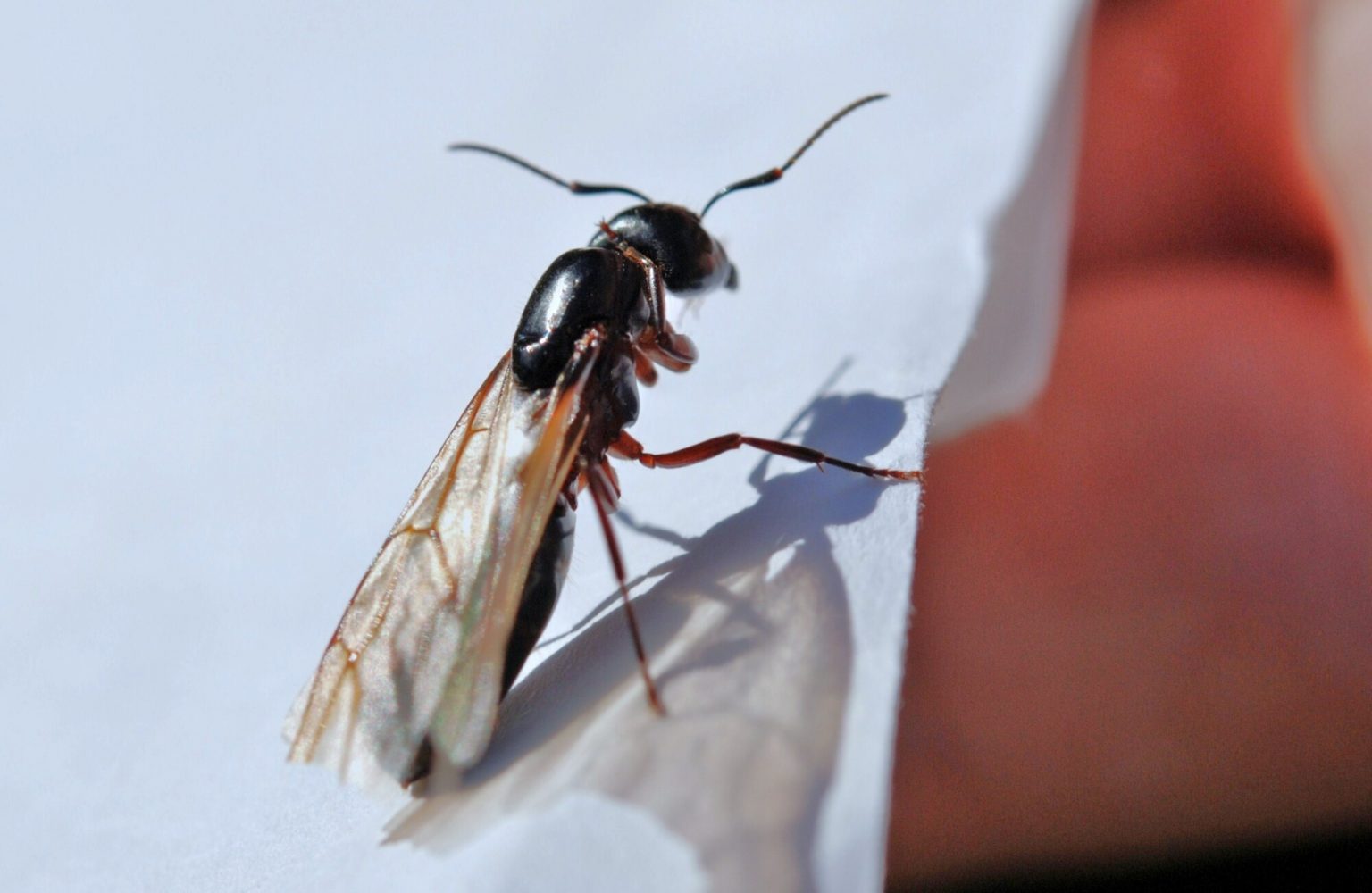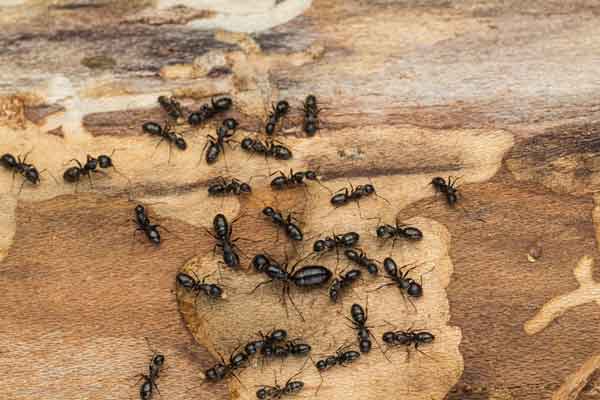Table Of Content
Carpenter ants are often confused with termites since both insects can cause substantial damage to the wood in a home's walls. Carpenter ants do not actually eat the wood, but instead, hollow it out with an extensive network of tunnels in which to establish colonies. This tunneling gradually opens up the wood to more moisture, more rot, and more weakening. Termites, however, actually consume the wood, unlike carpenter ants that merely tunnel through it, leaving behind residue (frass) in piles around the entry to the nest. Diatomaceous earth (DE) is a naturally occurring mineral made up of fossilized skeletons of diatoms, a form of algae. It is applied to ants in the same way as boric acid and works by the same principle.
Termites
The professional may also apply sprays using special equipment that creates an ultra-fine mist that penetrates wood more effectively than any method available to homeowners. Finally, a professional exterminator may apply perimeter treatments around the outside of your house in addition to addressing the nest itself. These perimeter applications may use residual pesticides that will kill any stray ants that attempt to enter your home in the following weeks and months, thereby preventing reinfestation. Next, deal with sources of nearby decaying wood outside the home. Chip up any tree stumps and make sure the debris is removed or mulched in an area well away from the home. Firewood piles should be located well away from the house or garage.
It's spring, and buggy home invaders are back - Nebraska Today
It's spring, and buggy home invaders are back.
Posted: Thu, 30 Mar 2023 07:00:00 GMT [source]
What Do Carpenter Ants Look Like?

Since these insects are mostly nocturnal, homeowners may not see carpenter ants with wings themselves. Wings are most likely to be found on windows or near cracks and crevices, especially in places where piles of frass have also accumulated. Regular ant bait is unlikely to be effective with carpenter ants, Pereira says. That’s why he recommends looking for bait that’s specially designed for carpenter ants. The hope is that the ants will take the bait back to the nest and destroy it. The same can’t be said of carpenter ants, which chew through rotten or damp wood, potentially damaging windows, doors, or even structural framing in the process.
Solved! This is How to Get Rid of Ants in the Kitchen Once and for All
Attack of the ants! - Northwest Arkansas Democrat-Gazette
Attack of the ants!.
Posted: Sat, 09 Apr 2016 07:00:00 GMT [source]
However, specially formulated carpenter ant baits available to professional pest managers and have been very effective. Place bait indoors where activity has been observed or is suspected. Monitor bait and place more if it is consumed or remove it if there is no activity. Carpenter ants do not eat wood but instead construct their nests in wood by chewing an interconnecting series of tunnels and cavities.
Signs of a Carpenter Ant Infestation
Pure pyrethrin has fairly low toxicity since it is a natural product based on an extract from chrysanthemum flowers. Pyrethrin-based insecticides work by exciting the central nervous system of the insects, causing paralysis and death. But some insecticides blend pyrethrin with other chemicals, known as synergists, to increase their longevity and effectiveness.
Damage
What exactly are they, how did they get in and what are they looking for? Unfortunately, most big black ants found in people’s homes are carpenter ants. They’re called carpenter ants because they build their homes in wood by chewing and tunneling through it. Much like termites, if they aren’t discovered and eliminated, carpenter ants can cause a lot of hidden structural damage in a home. When carpenter ants build their nests, usually in damp or decaying wood, they dig out tunnels which weakens the wood from the inside.
A professional can also tell the homeowner what damage has been done to their home, if any, so it can be fixed and the home’s structural integrity restored. Carpenter ants are one of the most common types of household ants in the United States. Carpenter ants are so named because they love to nest in wet wood and excavate it into a nest for their brood.

If you want to mix your own borax ant killer, it’s relatively easy to do. If they’re interested in liquid plan food during the day they are scavenging at night. These ants (Camponotus laevissimus) are part of the carpenter group of ants in California. Initially attracted by plants in gardens and backyards, these ants make their way inside the house. Their aggressiveness sometimes makes them hard to deal with as they often move their nest from one location of the house to another. This is why reducing interior humidity levels is part of a strategy of dealing with these ants when found inside homes.
Nests discovered during remodeling can be sprayed to halt ant dispersal, or the ants can be collected in a vacuum and discarded. Drilling holes to inject insecticide into all wall voids may be of limited benefit, especially if the walls contain insulation. Replace damaged or decayed wood and thoroughly seal the structure to eliminate future moisture problems. As noted earlier, carpenter ants seen in the home may actually be nesting outdoors, foraging indoors for food and/or moisture. Once the outdoor nest is discovered, treatment can be performed by spraying or drenching the nest with an insecticide such as carbaryl (Sevin), diazinon, or chlorpyrifos (Dursban).
There are 3 sub-species in this family with similar characteristics. These types of food include sugary foods such as syrup and honey. They made their way to California where they are considered household pests. Alternatively, try an insecticide that will be carried back to the nest, such as Vitax Nippon Ant Killer Liquid. Contact information for each states diagnostic laboratory for U.S. residents. If you live outside of Iowa please do not submit a sample without contacting the Plant & Insect Diagnostic Clinic.
A carpenter ant nest can exist in a house during winter but not be noticed. If the nest is in a place that does not receive sufficient indoor heat or sunshine, such as a north-facing outside wall, the ants will remain dormant until spring. On a bright sunny day, ants may be seen walking through different areas of the house.
Keep reading to learn about how to kill and repel ants safely. That said, ants may carry bacteria, making them potential transmitters of disease or infection. For example, a small 2019 animal study showed that Monomorium ants can carry pathogenic bacteria, which can be dangerous to people. Pesticides based on pyrethrins are considered safe to use around humans and are among the least toxic of pesticides—but they are still neurotoxins and should be used with care. Pyrethrins are toxic to fish and other aquatic life, and they have been known to cause serious allergic reactions in humans, especially asthma sufferers.
These ants (Camponotus modoc) are also common in California and parts of Western North America. They use trails or pathways to get out of the nest and move towards food. These ants live in large colonies, albeit smaller colonies compared to other more common California ants. The species (Tapinoma sessile) is known for nesting on all types of grounds.
They're attracted to sweets, so a little bit of jam or jelly can work. You can also mix equal parts sugar and baking soda, then place the mixture in a shallow dish. The sugar attracts the ants, but the baking soda will kill them naturally. To prevent carpenter ant problems indoors, eliminate high moisture conditions. They have one or two nodes and an uneven thorax when viewed in profile. It’s best to use neem oil around plants, especially where you see aphids or ants.
Ants farm aphids (small sap-sucking insects), so poisoning the aphids with neem oil can take care of both types of pests. The process, which may involve a professional contractor, can be a major undertaking if the damage has been extensive. Along with hiding in dewy, decomposing wood, you’ll often find carpenter ants colonizing behind dishwashers and air conditioning units, in the backs of moldy cabinets or around leaky pipes. They usually range from 3.4 to 13 millimeters long, according to Howard Russell, M.S., an entomologist at Michigan State University. Carpenter ants are often black, but some types have a reddish or yellowish shades to them.
The Black Harvester ant (Veromessor pergandei) is a typical harvester ant highly common in California. It harvests seeds and other types of foods it later stores in its nests in small chambers. By far the best course of action to keep ants outdoors where they belong is to remove the temptation to venture over the threshold of your home.

No comments:
Post a Comment